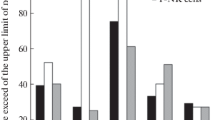Summary
Armadillo lepromin activates human lymphocytes from normal donors to release leucocyte inhibiting factor. The above activity was expressed optimally when leucocytes were incubated with lepromin at 37 °C, and only partially when incubation was carried out at 30 °C or at 35 °C. The possible mechanism of the in vitro production of lymphokine from lymphocytes stimulated by armadillo lepromin is discussed.
Zusammenfassung
Armadill-Lepromin aktiviert die menschlichen Lymphozyten gesunder Spender zur Freisetzung von Leukozytenhemmfaktor. Diese Aktivität kam optimal zum Ausdruck, wenn Leukozyten bei 37 °C mit Lepromin inkubiert wurden, jedoch nur teilweise, wenn die Inkubation bei 30 °C oder bei 35 °C erfolgte. Der mögliche Mechanismus der Erzeugung von Lymphokin in vitro aus Lymphozyten, die durch Armadill-Lepromin stimuliert wurden, wird besprochen.
Similar content being viewed by others
Literature
Kirchheimer, W. F., Storrs, E. E. Attempt to establish the armadillo (Dasypus novemcinctus, Lin.) as a model for the study of leprosy. I. Report of lepromatoid leprosy in experimental infected armadillo. Int. J. Lepr. 39 (1971) 693–702.
Binford, C. M., Storrs, E. E., Walsh, G. P. Disseminated infection in the nine-banded armadillo (Dasypus novemcintus) resulting from inoculation withMycobacterium leprae. Int. J. Lepr. 44 (1976) 80–83.
Sansarricq, H. Recent advances and present trends in leprosy research. Experientia 33 (1977) 114–119.
Walsh, G. P., Storrs, E. E., Burchfield, H. P., Cottrel, E. M., Vidrine, M. F., Binford, C. H. Leprosy-like disease occurring naturally in armadillo. J. Reticuloendothel. Soc. 18 (1975) 347–351.
Walsh, G. P., Storrs, E. E., Burchfield, H. P., Meyers, W. M., Convit, J. C.: Further studies on a leprosy-like disease found in a wild armadillo. Annual Meeting of the American Society for Microbiology, Atlantic City, 1976, Abstract B 17.
Walsh, G. P., Meyers, W. M., Binford, C. H., Storrs, E. E.: Naturally acquired leprosy in the wild armadillo: Recent finding. Annual Meeting of the American Society for Microbiology, New Orleans, 1977, Abstract B 45.
Kirchheimer, W. F. Recent advances in experimental leprosy. South Med. J. 69 (1976) 993–996.
Editorial: Indigenous leprosy found in armadillo. U.S. Medicine 12 (1976) 1–3.
Weiser, R. S. Natural leprosy-like disease in armadillos: A boon to leprosy research. J. Reticuloendothel. Soc. 18 (1975) 315–316.
Meyers, W. M., Kvernes, S., Binford, S. M. Comparison of reaction to human and armadillo lepromin in leprosy. Int. J. Lepr. 43 (1975) 218–225.
Purtilo, D. T., Storrs, E. E., Banks, I. S. Impact of cool temperatures on transformation of human and armadillo lymphocytes (Dasypus novemcinctus, Lin.) as related to leprosy. Nature 248 (1974) 450–452.
Purtilo, D. T., Walsh, G. P., Storrs, E. E., Gannon, C. The immune system of the nine-banded armadillo (Dasypus novemcinctus, Lin.). Anat. Rec. 181 (1975) 725–734.
Ulrich, M., Convit, J., Centeno, M., Rapetti, M. Immunological characteristics of the armadillo,Dasypus sabanicola. Clin. Exp. Immunol. 25 (1976) 170–176.
Boyum, A. Isolation of lymphocytes, granulocytes and macrophages. Scand. J. Immunol. 5, Suppl. 5 (1976) 9–15.
Clausen, J. E. Migration inhibition of human leucocytes mixed with phytohemagglutinin-preincubated mononuclear leucocytes. Acta Allergol. 30 (1975) 239–248.
Clausen, J. E. Inhibitory effect of cell free supernatant from phtohemagglutinin activated cultures of human mononuclear leucocytes. Acta Allergol. 31 (1976) 116–129.
Clausen, J. E. The agarose migration technique for in vitro demonstration of cell-mediated immunity. Dan. Med. Bull. 22 (1975) 181–193.
Levin, J., Bang, F. B. Clottable protein in Limulus: Its localization and kinetics of its coagulation by endotoxin. Thromb. Diath. Haemorrh. 19 (1968) 186–197.
Fumarola, D., Jirillo, E. Limulus test, parenteral drugs and biological products: An approach. Dev. Biol. Stand. 34 (1977) 97–100.
Hirsch, R. L., Jeffries, B. D., Gray, I. Temperature effects on lymphocyte transformation in vitro. Immunol. Commun. 6 (1977) 63–80.
Sultzer, B. M., Nilsson, B. S., Kirschenbaum, D. Non-specific stimulation of lymphocytes by tuberculin. Infect. Immun. 15 (1977) 779–806.
Author information
Authors and Affiliations
Rights and permissions
About this article
Cite this article
Fumarola, D., Jirillo, E. Leucocyte migration inhibition with armadillo Lepromin in human lymphocytes of healthy donors. Infection 6, 5–7 (1978). https://doi.org/10.1007/BF01641082
Received:
Issue Date:
DOI: https://doi.org/10.1007/BF01641082




